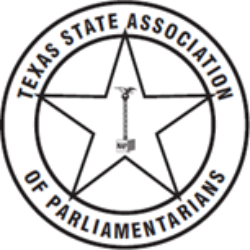On March 7, 1955, a group of women met in Houston to begin forming the Texas State Association of Parliamentarians. At that time, a Texan, Lou (Mrs. Roy) Rowntree, was serving as NAP first vice president. Looming on the calendar was the 10th NAP Convention to be held on October 25 and 26 at the old Shamrock Hilton Hotel in Houston. The grand strategy, understood by all that were present, was to use the NAP convention as the rallying point to establish a new state association while a Texan was installed as the 13th NAP president. Even though NAP had been in existence for 25 years, there were few state associations at that time. Indiana had been chartered in 1943, followed by Missouri in 1944, California in 1948, Kansas in 1951, and Florida in 1953. The addition of Texas was to be significant.
The old minutes book, with its hard cover and sewn binding intact, reveals the seminal moments for what was to become the second largest state association in NAP. Women’s names were recorded according to their husband’s name in the formal custom of the time, it would take some searching to find the occasional signature which would reveal a woman’s first name.
Three units were represented at that first meeting of the organizing convention, all from the Houston area. No doubt the NAP bylaws required at least three units to form an association. Having designated the first three as the Alpha, Beta, and Gamma units, the founders may have been a bit pragmatic in the selection of unit names. After all, these women were on a mission with a short timeline. Or possibly they were following California’s lead where only Greek letters have been used in unit names. The Delta and Epsilon units of Houston were added in the second year, which seems to support the latter theory, although the Midland and Houston Junior Forum units had been added in the first year as charter units. This author believes that the first three letters of the Greek alphabet may have been used as a convenience to get three units up and running beforehand.
In attendance were Flonnie Mae (Mrs. C.R.) Larimer, president of the Alpha unit, Betty (Mrs. John R.) Mooney, president of the Beta unit, and Flossie (Mrs. Doyle) Barton, president of the Gamma unit. Also attending were Lou Rowntree, Leona Hagy, and Mrs. Paul Carroll, who served as the chairman of the organizing convention. Betty Mooney was selected to chair the committee to draw up bylaws – a role she would play on and off for several years to come. On June 22, 1955, the second and final meeting of the organizing convention was held. Bylaws were adopted. The first officers of TSAP were: Flonnie Mae Larimer, president; Betty Mooney, 1st vice president; Mr. T. J. Smith, 2nd vice president (not sure if the “Mr.” is a typo); Flossie Barton, recording secretary; Mrs. A.J. Lanier, corresponding secretary; Leona Hagy, treasurer; and Mrs. R. H. Fore, historian. Preparations for hosting the upcoming NAP convention dominated the rest of the meeting.
The 10th NAP Convention was apparently a great success, according to the minutes of the TSAP Board meeting on December 30, 1955. All of the units helped make a contribution to the effort. The NAP convention was truly a confidence-building accomplishment. TSAP was off to a great start. New units would soon be added, such as Delta of Houston, Epsilon of Houston, the Houston Junior Forum, and the Women’s Parliament of Austin. A Texan was at the helm of NAP and several of the founders were committed to carrying TSAP into the future. Betty Mooney followed Larimer as TSAP president, and served as 4th vice president of NAP in 1959-1961 and 3rd vice president of NAP in 1961-1963. Next in line was Leona Hagy, who followed Mooney as TSAP president. Lou Rowntree would serve as NP editor in 1960-1961 and as NAP parliamentarian in 1961-1963. Rowntree also became TSAP president in 1963. With time, new names were woven into the TSAP leadership team, such as Gerta Morris, Nora Elich, and Lena Hardcastle, to name a few.
Just as NAP seemed to develop around a focal point in Missouri, so it was with TSAP using Houston as the cornerstone for growth. By 1958, units would form in Dallas and eventually in Fort Worth and San Antonio. All of these cities have developed strong leaders for both TSAP and NAP. Many more will come from all parts of Texas in the future!
Special thanks to Sandra Burrell, Sam Houston Regional Library, and Sarah Nieft, NAP Executive Director, for their help in researching this article. This history was compiled by Kirk Overbey, PRP.
